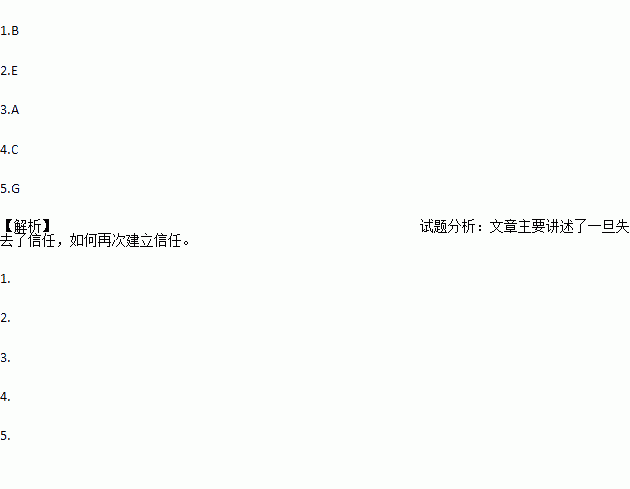题目内容
Building Trust in a Relationship Again
Trust (信任)is a learned behavior(习得行为) that we gain from past experiences(以往经历). 1.Trust is a risk.But you can’t be successful when there’s a lack of trust in a relationship that results from an action where the wrongdoer takes no responsibility to fix the mistake.
Unfortunately,we’ve all been victims of betrayal(背信).Whether we’ve been stolen from,lied被欺骗 to,misled被误导,or cheated on被哄骗,there are different levels of losing trust.Sometimes people simply can’t trust anymore(有时候人们就是不能再信任别人). 2. It’s understandable(可理解的),but if you’re willing to build trust in a relationship(人际关系) again,we have some steps you can take to get you there.
3. Having confidence in yourself will help you make better choices because you can see what the best outcome结果 would be for your well-being幸福.
4.If you’ve been betrayed(如果你遭遇了背叛),you are the victim(受害者) of your circumstance(客观环境).But there’s a difference between being a victim and living with a “victim mentality”(“受害者的心态”).At some point in all of our lives,we’ll have our trust tested or violated. 被破坏
You didn’t lose “everything”.Once trust is lost,what is left? Instead of looking at the situation from this hopeless angle角度,look at everything you still have and be thankful for all of the good in your life.5.Instead,it’s a healthy way to work through the experience to allow room余地 for positive growth and forgiveness(宽恕).
A.Learn to really trust yourself.
B.It is putting confidence in someone(对某人寄托信任).
C.Stop regarding yourself as the victim.
D.Remember that you can expect the best in return.
AB.They’ve been too badly hurt and they can’t bear to let it happen again. .(他们曾经受过严重伤害,不能容忍这种事情再次发生。)
AC.This knowledge carries over in their attitude toward their future relationships.
AD.Seeing the positive(积极的) side of things doesn’t mean you’re ignoring(忽视) what happened.


 powerful story of brotherhood, bravery and understanding carried out.
powerful story of brotherhood, bravery and understanding carried out.